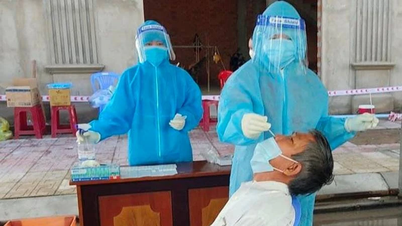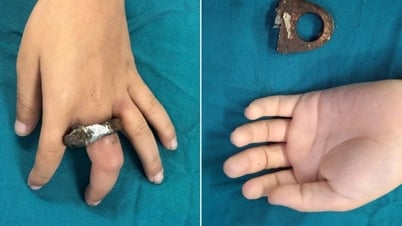NDO - Mixed connective tissue disease, is a rare autoimmune disease characterized by clinical features of systemic lupus erythematosus, systemic sclerosis, and polymyositis, with very high concentrations of antinuclear antibodies against the Ribonucleoprotein antigen.
Recently, Medlatec General Hospital received Ms. NTH (30 years old) for examination due to unusual red rashes on both cheeks. Medical history revealed that Ms. H. has had thrombocytopenia of unknown cause for 10 years and is currently taking 2mg/day of medrol.
On examination, the patient had skin lesions with unclear erythema on both cheeks, the skin was taut and discolored, the surface was not scaly and there were no blisters. The ANA test by immunofluorescence method was positive, with the phenotype Speckled AC-4 (2+) and Cytoplasmic AC-20 (1+). Autoantibodies such as Anti-nRNP/Sm, Anti-DsDNA, Histones, Anti-SS-A, Anti-Ro-52 were all positive, while Scl-70, CENP A and CENP B were positive. Blood tests showed thrombocytopenia to 71 G/L.
Based on clinical and paraclinical results, Ms. H. was diagnosed with mixed connective tissue disease, a rare autoimmune disease characterized by clinical symptoms of systemic lupus erythematosus, systemic sclerosis, and polymyositis, with very high concentrations of antinuclear antibodies against the Ribonucleoprotein antigen.
Patients are prescribed a personalized treatment regimen, appropriate to their specific condition, and are advised to avoid direct exposure to sunlight to reduce the risk of worsening the disease.
Master, Doctor Tran Thi Thu - Dermatology specialist, Medlatec General Hospital said, Mixed Connective Tissue Disease (MCTD) is an autoimmune disease, with the rate of women suffering from the disease 9 times higher than men, mostly appearing in adulthood.
The disease is characterized by symptoms of damage in many organs, intersecting the clinical features of different autoimmune diseases such as: systemic lupus erythematosus, systemic sclerosis, dermatomyositis/polymyositis, rheumatoid arthritis...
The exact cause of the disease is still unknown, but there are some risk factors. Regarding genetic factors, if a family member has an autoimmune disease, there is a high risk of developing a connective tissue disease. Some genes such as HLA-DR, HLA-DQ, if mutated, can cause the immune system to mistakenly identify the body's normal tissues as "enemies" and attack them. This increases the risk of developing autoimmune diseases, including connective tissue diseases.
Environmental factors such as viral infections (EBV, CMV), exposure to toxic chemicals (silica dust, pesticides) and ultraviolet (UV) rays can trigger abnormal immune responses, causing autoimmune disorders, especially in people with sensitive constitutions.
The hormone estrogen can affect immune system function, increasing the risk of developing autoimmune disorders in women.
In connective tissue disease, the body produces autoantibodies such as ANA (antinuclear antibodies) and anti-U1-RNP. These autoantibodies mistakenly identify normal proteins in the body as "enemies", leading to the immune system attacking its own tissues and organs, causing autoimmune disorders.
According to Dr. Thu, symptoms of connective tissue diseases are very diverse, depending on each specific disease, with manifestations ranging from mild to severe, affecting many organ systems in the body.
In the early stages of the disease, symptoms are often nonspecific, such as fatigue, muscle/joint pain, and low-grade fever. More specific symptoms include Raynaud's syndrome, which is characterized by cold, white fingers that turn blue and finally red when exposed to cold or emotional disturbances. Some cases may have joint deformities similar to rheumatoid arthritis.
In the later stages of the disease, if not detected and treated promptly, the disease can cause damage to multiple organs in the body and many serious complications such as: myocarditis, mitral valve prolapse, interstitial pneumonia, pulmonary hypertension, autoimmune hepatitis, nephrotic syndrome, glomerulonephritis, aseptic meningitis, cauda equina syndrome...
Symptoms may appear simultaneously or progress gradually over time, seriously affecting quality of life and even being life-threatening if not diagnosed and treated promptly.
To reduce the risk of disease and control it effectively, Dr. Thu recommends seeing a specialist when unusual symptoms appear and having regular health check-ups to detect complications early.
In addition, it is necessary to avoid sunlight, use sunscreen, do not smoke, keep the body warm in cold weather, maintain a balanced diet, supplement omega-3, exercise gently, and manage stress through relaxation methods such as meditation or yoga.
MCTD is a complex autoimmune disease that is difficult to diagnose due to its overlapping features with other autoimmune diseases. Differentiating MCTD from overlap syndromes and differentiated autoimmune diseases such as systemic lupus erythematosus, systemic sclerosis, or dermatomyositis is a clinical challenge. Because MCTD can progress to differentiated autoimmune diseases over many years, follow-up and accurate diagnosis are important.
Source: https://nhandan.vn/benh-mo-lien-ket-hiem-gap-nhung-de-bien-chung-nguy-hiem-post855617.html



![[Photo] T&T 1 and Ho Chi Minh City 1 People's Police Teams won the men's and women's team championships](https://vphoto.vietnam.vn/thumb/1200x675/vietnam/resource/IMAGE/2025/5/22/39db06ae67cb4001b7a556e8d9a56d07)
![[Photo] Press delegation meeting to visit Truong Sa and DK1 Platform](https://vphoto.vietnam.vn/thumb/1200x675/vietnam/resource/IMAGE/2025/5/22/6b8d232877ec421a9e8187d83b9f8006)

![[Photo] Prime Minister Pham Minh Chinh chairs meeting on draft Resolution of National Assembly on International Financial Center in Vietnam](https://vphoto.vietnam.vn/thumb/1200x675/vietnam/resource/IMAGE/2025/5/22/d398664ff1a140629169ea5a24e1b4d0)
![[Photo] General Secretary To Lam chairs a working session with the Central Internal Affairs Commission](https://vphoto.vietnam.vn/thumb/1200x675/vietnam/resource/IMAGE/2025/5/22/3b7790f499da45b2803d8ae253207ef1)













![[Photo] T&T 1 and Ho Chi Minh City 1 People's Police Teams won the men's and women's team championships](https://vphoto.vietnam.vn/thumb/402x226/vietnam/resource/IMAGE/2025/5/22/39db06ae67cb4001b7a556e8d9a56d07)


![[Photo] Prime Minister Pham Minh Chinh chairs meeting on draft Resolution of National Assembly on International Financial Center in Vietnam](https://vphoto.vietnam.vn/thumb/402x226/vietnam/resource/IMAGE/2025/5/22/d398664ff1a140629169ea5a24e1b4d0)
![[Photo] Press delegation meeting to visit Truong Sa and DK1 Platform](https://vphoto.vietnam.vn/thumb/402x226/vietnam/resource/IMAGE/2025/5/22/6b8d232877ec421a9e8187d83b9f8006)
























































![[Podcast] Week introducing more than 500 OCOP products in Hanoi](https://vphoto.vietnam.vn/thumb/402x226/vietnam/resource/IMAGE/2025/5/22/d144aac2416744718388dbae3260e7fd)





Comment (0)